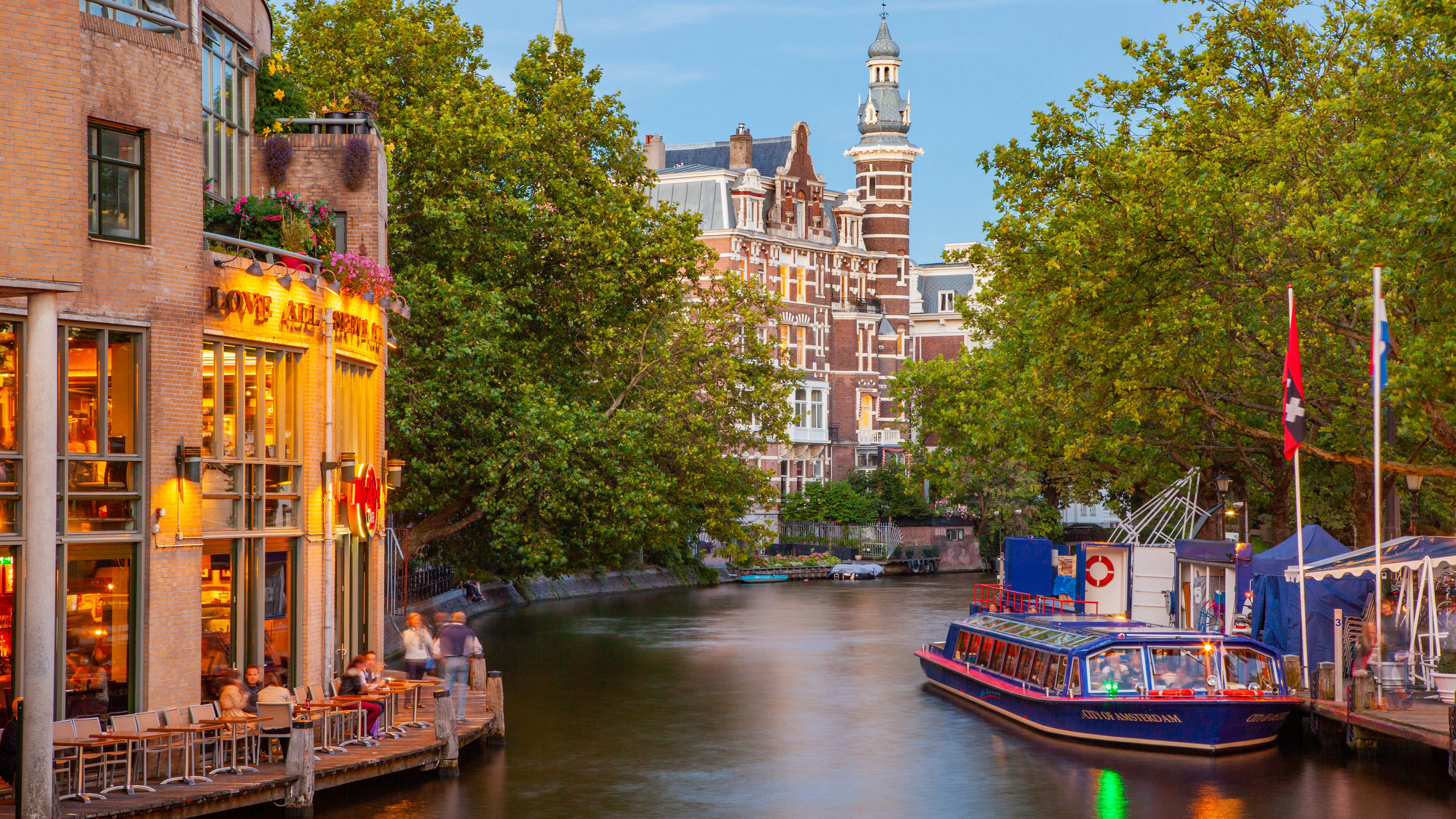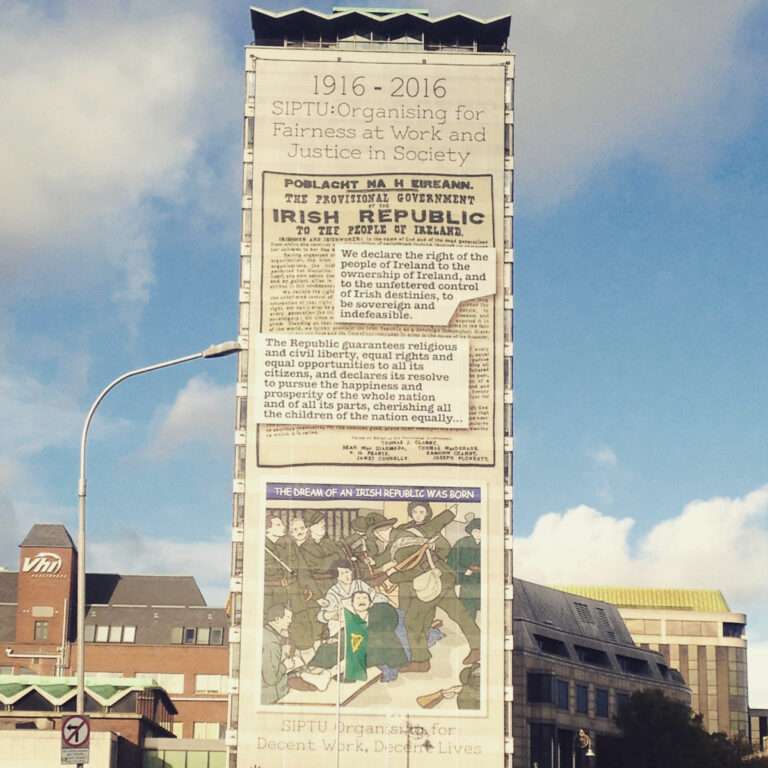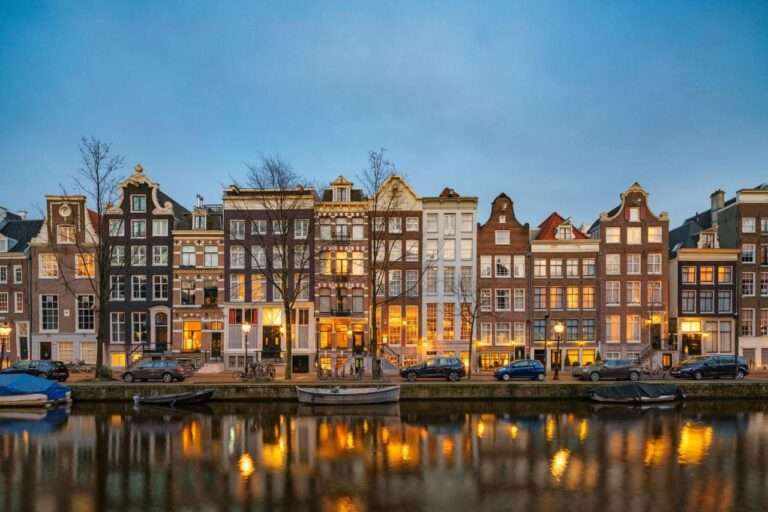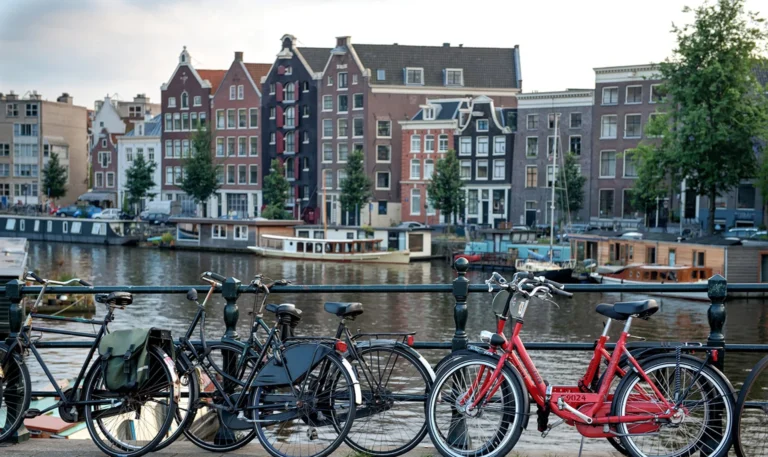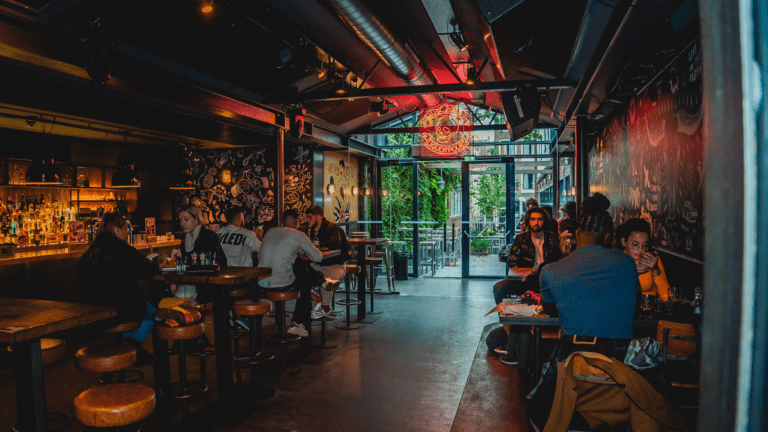The Netherlands has long been a magnet for travelers and tourists. But beyond its appeal as a tourist destination, Amsterdam has quietly emerged as one of Europe’s most attractive destinations for digital nomads. Amsterdam’s excellent infrastructure, tolerant cultural scene, and welcoming atmosphere make it an ideal base for remote workers seeking both productivity and a high quality of life.
Whether you’re lured by the idea of cycling along historic streets, working from a café overlooking a canal, or diving into the city’s museums during your off hours, Amsterdam offers professional opportunities and lifestyle perks. In this guide, I’ll delve into everything you need to know about living and working as a digital nomad in Amsterdam—from practicalities like accommodation and coworking spaces to cultural insights and tips for making the most of your time in this dynamic city.
Can I Be a Digital Nomad in Amsterdam?
Absolutely! Amsterdam has become a hotspot for digital nomads, thanks to its excellent quality of life, diverse population, and the presence of many international companies. Amsterdam’s creative energy makes it an ideal environment for remote workers. Digital nomads in Amsterdam benefit from a mix of cultural experiences, professional networking opportunities, and a lifestyle that blends work and leisure seamlessly.
Amsterdam’s appeal as a digital nomad destination also lies in its compact size and accessibility. The city’s well-connected public transport system and bike-friendly infrastructure make it easy to get around, whether you’re commuting to a coworking space or exploring the city’s neighborhoods. Moreover, the Dutch are known for their proficiency in English, which eliminates language barriers and makes daily life more straightforward for international residents.
Can I Work Remotely from Amsterdam?
Yes, you can work remotely from Amsterdam. Amsterdam has embraced the rise of remote work, offering a wide range of coworking spaces, cafes with fast and reliable Wi-Fi, and a growing community of freelancers, entrepreneurs, and digital nomads. Whether you’re a tech professional, a writer, a designer, or any other type of remote worker, Amsterdam provides an environment that encourages productivity and creativity.
Amsterdam’s infrastructure is well-suited to remote work. You’ll find that most accommodations, whether short-term rentals or longer-term leases, come equipped with high-speed internet. Additionally, many cafes and public spaces offer free Wi-Fi, making it easy to work from virtually anywhere in the city. Amsterdam’s work culture is also conducive to a balanced lifestyle, with a strong emphasis on work-life balance and plenty of opportunities to socialize and network with other professionals.
Does Amsterdam Have a Digital Nomad Visa?
Currently, the Netherlands does not offer a specific digital nomad visa. However, several other visa options might work depending on your nationality and situation.
For Americans, the process is simple—there’s no need for a visa, we are able to remain in The Netherlands for up to 3 months with just our passports. EU/EEA and Swiss citizens can live and work in Amsterdam as freely as you would in your home country. Non-EU citizens, however, will need to navigate the Schengen visa system, which allows for stays of up to 90 days within a 180-day period. This is ideal for digital nomads who plan to move frequently within Europe, but if you’re considering a longer stay, you’ll need to explore other options.
For longer stays, non-EU citizens might consider applying for a freelancer visa, which is designed for self-employed individuals, or a startup visa if you’re planning to launch a business. Both options require some upfront investment and paperwork, but they offer the possibility to live and work in the Netherlands for an extended period. If you’re American and want to extend your time in the Netherlands, consider using the Dutch-American Friendship Treaty.
Where Is Amsterdam Located?
Amsterdam is the capital city of the Netherlands, located in the western part of the country. It lies within the province of North Holland, not far from the North Sea coast. Amsterdam’s strategic location at the heart of Europe makes it a convenient base for travel, with major cities like Paris, Berlin, and London just a few hours away by train or flight.
Amsterdam is also well-connected by waterways, with its network of canals linked to the Rhine River and the North Sea. This central location has historically made Amsterdam a hotspot for trade and commerce, and today it continues to be a key player in the European economy. The Netherland’s position within the European Union also enhances its appeal for international business and travel.
Is Amsterdam Part of the UK or Europe?
Amsterdam is part of Europe and serves as the capital of the Netherlands, a country in the European Union. It is not part of the UK, though it shares a long history of trade and cultural exchange with the United Kingdom. The Netherlands is one of the founding members of the EU, and Amsterdam plays a significant role in European politics, finance, and culture.
Being part of the EU means that Amsterdam benefits from the free movement of people, goods, and services within the European Single Market. This makes it easier for EU citizens to live and work in Amsterdam without the need for a visa. For digital nomads from outside the EU, Amsterdam’s status as a major European city ensures a high standard of living, robust infrastructure, and access to a wide range of services and amenities.
What is the Best Way to Get to Amsterdam from London?
Traveling from London to Amsterdam is straightforward and can be done via several convenient options, each offering its own advantages depending on your preferences and budget.
- Train: The Eurostar train is one of the most popular options for traveling between London and Amsterdam. Departing from London St Pancras, the Eurostar offers a direct service to Amsterdam Central Station, with the journey taking around 4 hours. This option is not only comfortable but also environmentally friendly, as it produces a lower carbon footprint compared to flying. The Eurostar also allows you to work during the journey, with onboard Wi-Fi and power outlets available in most seats.
- Flight: If speed is your priority, flying is the quickest way to get from London to Amsterdam. Direct flights are available from all major London airports (Heathrow, Gatwick, City, Luton, and Stansted) to Amsterdam Schiphol Airport, with the flight time being just over an hour. However, when considering the time spent on airport transfers, security checks, and boarding, the total travel time can be comparable to taking the train.
- Bus: For budget-conscious travelers, taking a bus from London to Amsterdam is the most economical option. Companies like FlixBus and Eurolines operate regular services between the two cities, with the journey taking around 10 hours. While this option is the least expensive, it is also the longest, so it’s best suited for those without time constraints and looking to save money.
- Ferry: Another alternative is to take a ferry from Harwich to Hook of Holland and then travel by train to Amsterdam. While this option takes longer, it can be a scenic and relaxing journey, especially if you prefer a leisurely pace and enjoy the experience of sea travel.
What’s the Closest Airport to Amsterdam?
The closest airport to Amsterdam is Amsterdam Schiphol Airport (AMS), which is located approximately 15 kilometers (9 miles) southwest of the city center. Schiphol is one of the busiest airports in Europe, serving as a major hub for both international and domestic flights. The airport is well-connected to the city by train, with regular services running between Schiphol Airport and Amsterdam Central Station. The train journey takes about 15-20 minutes, making it quick and convenient to reach the heart of the city after your flight.
Schiphol Airport is also a gateway to the rest of Europe, with numerous flights to other major European cities. For digital nomads who plan to travel frequently, Schiphol’s extensive flight network is a significant advantage, offering easy access to destinations across Europe and beyond.
What Language is Spoken in Amsterdam?
The official language spoken in Amsterdam is Dutch. However, one of the many advantages of living in Amsterdam as a digital nomad is the widespread use of English. Amsterdam is an international city, and the majority of residents, particularly in the business and tourism sectors, are fluent in English. This makes it incredibly easy for non-Dutch speakers to navigate daily life, from shopping and dining to professional interactions.
In addition to Dutch and English, you’ll also hear a variety of other languages spoken around the city, reflecting Amsterdam’s multicultural population. However, while English will get you far, learning a few basic Dutch phrases can enhance your experience and endear you to the locals. Simple greetings like “hallo” (hello) and “dank je” (thank you) can go a long way in making a good impression.
Is Amsterdam Worth Visiting?
Without a doubt, Amsterdam is worth visiting, whether you’re a digital nomad or simply exploring Europe. The city is renowned for its stunning architecture, rich cultural heritage, and vibrant arts scene. From the moment you arrive, you’ll be captivated by the charm of Amsterdam’s historic canals, the beauty of its 17th-century buildings, and the energy of its bustling streets.
Amsterdam offers something for everyone. Art lovers can visit the Dutch Masters at the Rijksmuseum and Van Gogh Museum, while history buffs can explore the Anne Frank House or the Dutch Resistance Museum. If you’re more interested in contemporary culture, Amsterdam is home to a thriving creative scene, with numerous galleries, design studios, and innovative restaurants to discover.
Beyond its cultural attractions, Amsterdam is a city of contrasts. You can spend your days working in a sleek coworking space and your evenings exploring cozy, centuries-old pubs or modern rooftop bars with stunning views of the city. Whether you’re here for a short visit or an extended stay, Amsterdam’s is a destination that will leave a lasting impression.
What is the Best Month to Visit Amsterdam?
The best time to visit Amsterdam depends on your preferences and what you want to experience. Each season brings its own unique charm to the city:
- Spring (April to May): Spring is one of the most popular times to visit Amsterdam, as the city comes alive with blooming flowers and mild weather. The famous tulip fields are in full bloom, and you can visit the Keukenhof Gardens, which are a short trip from the city. The weather during spring is generally pleasant, with temperatures ranging from 10°C to 15°C (50°F to 59°F), making it perfect for outdoor activities.
- Summer (June to August): Summer is the peak tourist season in Amsterdam, with warm weather, long daylight hours, and a lively atmosphere. Temperatures typically range from 18°C to 25°C (64°F to 77°F), making it ideal for cycling, canal cruises, and outdoor dining. However, summer also brings larger crowds and higher prices, so it’s important to book accommodation and activities well in advance.
- Autumn (September to November): Autumn in Amsterdam is characterized by cooler temperatures, ranging from 10°C to 15°C (50°F to 59°F), and the city’s parks and streets are adorned with colorful foliage. This season is less crowded, offering a more relaxed experience. It’s also a great time to explore Amsterdam’s cultural attractions, as many museums and galleries host special exhibitions during this period.
- Winter (December to February): Winter in Amsterdam is cold, with temperatures ranging from 0°C to 6°C (32°F to 43°F), but the city takes on a magical quality during this time. The canals may freeze over, creating opportunities for ice skating, and the city’s Christmas markets and light displays add a festive charm. Winter is also the off-season for tourism, so you’ll find lower prices on accommodation and flights.
How Long Should I Stay in Amsterdam?
The ideal length of stay in Amsterdam depends on your goals. If you’re visiting as a tourist, a 3 to 5-day trip is enough to see the major attractions and get a feel for the city. This timeframe allows you to explore the historic city center, visit a few coffee shops, take a canal cruise, and enjoy some of the local cuisine.
For digital nomads, the length of stay can vary widely depending on work commitments and travel plans. Many digital nomads choose to stay in Amsterdam for a few weeks to several months. A longer stay allows you to immerse yourself in the local culture, establish a work routine, and fully experience the city’s vibrant lifestyle. Additionally, a longer stay gives you more time to explore different neighborhoods, meet other digital nomads, and take day trips to nearby destinations.
What is Amsterdam Weather Like?
Amsterdam’s weather is unpredictable, with frequent changes throughout the day. The city has a temperate maritime climate, which means mild summers and cool, damp winters. Rain is common year-round, so it’s always a good idea to carry an umbrella or a waterproof jacket, no matter the season.
- Spring: Spring weather in Amsterdam is mild and variable, with temperatures ranging from 10°C to 15°C (50°F to 59°F). You can expect a mix of sunny days and occasional showers. The blooming tulips and fresh greenery make this a beautiful time to visit, despite the occasional rain.
- Summer: Summers in Amsterdam are generally warm, with temperatures ranging from 18°C to 25°C (64°F to 77°F). However, heatwaves are rare, and the city’s coastal location keeps temperatures comfortable. Summer also sees the most daylight hours, with long evenings perfect for outdoor activities.
- Autumn: Autumn brings cooler temperatures, ranging from 10°C to 15°C (50°F to 59°F), and the city’s parks and gardens are awash with vibrant fall colors. Rain becomes more frequent during this season, so be prepared for occasional wet days.
- Winter: Winters in Amsterdam are cold, with temperatures ranging from 0°C to 6°C (32°F to 43°F). Snow is rare but not unheard of, and the city takes on a cozy atmosphere with its festive lights and Christmas markets. The shorter days and colder temperatures make it a quieter time to visit, with fewer tourists and lower prices.
Is Amsterdam Safe for Digital Nomads?
Amsterdam is generally considered a very safe city for digital nomads and travelers alike. The Netherlands, in general, has low crime rates, and Amsterdam is no exception. Violent crime is rare, and the most common issue is petty theft, such as pickpocketing in crowded areas or on public transport. By taking basic precautions, such as keeping your belongings secure and being aware of your surroundings, you can minimize the risk of theft.
The city is also very safe for solo travelers, including women. The Dutch are known for their tolerance and openness, and Amsterdam’s international vibe means that you’ll often find yourself in a diverse, welcoming environment. The extensive cycling infrastructure also contributes to safety, as cyclists are a priority on the roads, making it easier and safer to navigate the city by bike.
As with any city, it’s important to stay informed and follow local advice, especially when it comes to areas that might be less safe at night. However, most digital nomads find Amsterdam to be a very secure and comfortable place to live and work.
Is Amsterdam Expensive For Digital Nomads?
Amsterdam is known for its high cost of living, particularly when it comes to accommodation. However, with careful budgeting and planning, living comfortably in the city as a digital nomad is possible.
- Accommodation: The cost of renting an apartment or room in Amsterdam can be quite high, especially in popular neighborhoods like the Jordaan or De Pijp. However, there are more affordable options available if you’re willing to look outside the city center or opt for a shared living arrangement. Platforms like VRBO offer a range of short-term and long-term rental options, and there are also co-living spaces specifically designed for digital nomads and remote workers.
- Food and Dining: Dining out in Amsterdam can vary widely in cost. While there are plenty of high-end restaurants, there are also many affordable options, including street food, markets, and casual eateries. Cooking at home is another way to save money, and the city has numerous supermarkets and local markets where you can buy fresh produce and groceries.
- Transportation: Amsterdam’s public transport system is efficient and relatively affordable, especially if you purchase a multi-day or monthly pass. However, cycling is the preferred mode of transport for many residents and is a cost-effective way to get around the city. You can rent a bike for a reasonable price, or if you’re staying longer, consider buying a second-hand bike.
- Entertainment and Activities: The cost of entertainment in Amsterdam can add up, but there are plenty of free or low-cost activities to enjoy, such as exploring the city’s parks, taking a walk along the canals, or visiting one of the many free events and festivals. Museums and galleries often offer discounted or free entry on certain days, and there are also plenty of affordable cultural experiences to enjoy.
Overall, while Amsterdam is not the cheapest destination for digital nomads, the city’s quality of life, cultural offerings, and opportunities for professional growth make it a worthwhile investment. With careful budgeting and smart choices, you can enjoy everything the city has to offer without breaking the bank.
What Currency Is Used in Amsterdam?
The currency used in Amsterdam is the Euro (€). As part of the Eurozone, the Netherlands adopted the Euro in 2002, replacing the Dutch guilder. Euros come in denominations of 5, 10, 20, 50, 100, 200, and 500 euro notes, and coins are available in 1, 2, 5, 10, 20, and 50 cents, as well as 1 and 2 euro coins.
Most businesses in Amsterdam accept credit and debit cards, and contactless payments are widely used. However, it’s a good idea to carry some cash, especially for smaller purchases or at places that may not accept cards, such as local markets or small cafes. ATMs are widely available throughout the city, and most accept international cards.
If you’re staying in Amsterdam for an extended period, you might consider opening a local bank account, although this can be challenging for non-residents. Alternatively, online banks like N26 or Revolut offer convenient solutions for managing your finances while abroad, allowing you to hold and exchange multiple currencies at competitive rates.
Intracity Travel: How to Get Around in Amsterdam
Getting around in Amsterdam is easy and convenient, thanks to the city’s excellent public transport system and bike-friendly infrastructure. Here are the main options for intracity travel:
- Cycling: Amsterdam is one of the most bike-friendly cities in the world, with dedicated bike lanes, bike parking facilities, and an overall infrastructure designed to prioritize cyclists. Biking is often the fastest and most efficient way to get around the city, especially in the narrow streets of the historic center. You can rent a bike from one of the many rental shops around the city, or if you’re staying for a longer period, consider buying a second-hand bike. Cycling in Amsterdam is safe, but be sure to follow the local rules, such as using bike lights at night and signaling your turns.
- Public Transport: Amsterdam’s public transport system is operated by GVB and includes trams, buses, and the metro. The tram network is extensive and covers most of the city, making it a convenient option for getting around, especially if you’re traveling between neighborhoods. The metro is useful for longer journeys, particularly to areas outside the city center. Buses are also available, although they are less frequently used within the central areas. You can buy single-use tickets, day passes, or opt for an OV-chipkaart, a reloadable card that offers discounted fares and can be used across all forms of public transport.
- Walking: Amsterdam is a compact city, and many of the major attractions are within walking distance of each other. Walking is a great way to explore the city’s historic neighborhoods, discover hidden courtyards, and enjoy the scenic canal views. The city’s pedestrian areas are well-maintained, and there are plenty of cafes and shops where you can take a break along the way.
- Boats and Ferries: Given Amsterdam’s extensive canal network, boat travel is another option, especially for sightseeing. Canal cruises are popular with tourists, offering a unique perspective of the city. For regular transport, free ferries operated by GVB run across the IJ River, connecting the city center with the northern neighborhoods, such as Amsterdam Noord.
- Taxis and Ride-Sharing: Taxis are available in Amsterdam, but they are relatively expensive compared to other forms of transport. Uber is also widely used in the city, offering a more convenient and often more affordable alternative to traditional taxis. However, given the city’s compact size and efficient public transport, you may find that you rarely need to use taxis.
Which Areas Are Available to Stay in Amsterdam?
Amsterdam is divided into several neighborhoods, each with its own unique character and appeal. Here are some of the most popular areas for digital nomads to stay:
- Jordaan: One of Amsterdam’s most iconic neighborhoods, Jordaan is known for its narrow streets, picturesque canals, and vibrant atmosphere. The area is home to a mix of trendy boutiques, cafes, and galleries, making it a popular choice for creative professionals. Accommodation in Jordaan can be pricey, but the central location and charming surroundings make it a worthwhile investment.
- De Pijp: Located just south of the city center, De Pijp is a lively and multicultural neighborhood known for its diverse dining options, vibrant markets, and artistic vibe. The area is popular with young professionals and digital nomads, offering a mix of affordable apartments and coworking spaces. De Pijp is also home to the famous Albert Cuyp Market, where you can find everything from fresh produce to unique souvenirs.
- Amsterdam Oud-Zuid: For those seeking a more upscale experience, Amsterdam Oud-Zuid is the place to be. This affluent neighborhood is home to some of the city’s most prestigious museums, including the Rijksmuseum and Van Gogh Museum, as well as high-end boutiques and gourmet restaurants. Accommodation in Oud-Zuid is on the pricier side, but the area’s elegant surroundings and proximity to cultural attractions make it an attractive option.
- Amsterdam Noord: Across the IJ River from the city center, Amsterdam Noord offers a more laid-back and affordable alternative to the central neighborhoods. The area has undergone significant development in recent years, transforming from an industrial district into a trendy neighborhood with creative spaces, cafes, and modern apartments. Amsterdam Noord is also home to several coworking spaces, making it a convenient option for digital nomads.
- Westerpark: Westerpark is a vibrant and creative neighborhood located west of the city center. The area is named after the large public park that serves as its centerpiece, offering plenty of green space for outdoor activities. Westerpark is also known for its cultural venues, including art galleries, theaters, and music venues, making it a popular choice for those interested in the arts. Accommodation in Westerpark is more affordable than in the central neighborhoods, and the area’s relaxed vibe appeals to digital nomads seeking a more local experience.
Digital Nomad Accommodation Options in Amsterdam
Finding the right accommodation is key to a successful stay in Amsterdam as a digital nomad. The city offers a wide range of options, from short-term rentals to co-living spaces, each catering to different needs and budgets. For more information, this post covers everything about finding the perfect accommodation in Amsterdam.
- VRBO Rentals: VRBO is a popular platform for finding short-term rentals in Amsterdam, offering a wide selection of apartments, houses, and private rooms. VRBO is ideal for digital nomads who value privacy and prefer to have their own space. The platform allows you to search for properties based on your specific needs, such as Wi-Fi speed, workspace availability, and proximity to public transport. Prices vary depending on the location and the type of accommodation, but you can often find good deals, especially if you book in advance or stay for an extended period.
- Co-Living Spaces: Co-living spaces are becoming increasingly popular among digital nomads, offering a community-oriented living experience with shared amenities. These spaces often come with fully furnished rooms, high-speed internet, and communal areas such as kitchens, lounges, and coworking spaces. Co-living is a great way to meet other digital nomads and professionals, making it easier to build a network and make new friends. Some popular co-living spaces in Amsterdam include Zoku, The Student Hotel, and StartDock.
- Serviced Apartments: If you’re planning a longer stay and want the convenience of hotel-like services, serviced apartments are a good option. These apartments come fully furnished and include amenities such as housekeeping, laundry services, and 24-hour concierge support. While more expensive than standard rentals, serviced apartments offer a hassle-free living experience, ideal for busy professionals who want to focus on work rather than managing household chores.
- Amsterdam Hostels: For budget-conscious travelers, hostels are an affordable accommodation option in Amsterdam. Many hostels in the city cater specifically to digital nomads, offering private rooms, communal kitchens, and workspaces with fast Wi-Fi. Staying in a hostel is also a great way to meet fellow travelers and exchange tips and experiences. Some hostels even organize social events, making it easy to connect with others.
- House-Sitting and Home Exchanges: If you’re looking for a unique and cost-effective way to stay in Amsterdam, consider house-sitting or participating in a home exchange program. House-sitting involves taking care of someone’s home (and often pets) while they’re away, in exchange for free accommodation. Home exchanges allow you to swap homes with someone in another city or country, offering a more personal and local living experience.
Coworking in Amsterdam
Amsterdam has a thriving coworking scene, with numerous spaces catering to different industries and work styles. Whether you prefer a sleek, modern environment or a cozy, community-focused space, you’ll find a coworking option that suits your needs in Amsterdam.
- Spaces: Spaces is one of the most well-known coworking brands in Amsterdam, offering multiple locations across the city. Each Spaces location is designed with productivity in mind, featuring modern workstations, high-speed internet, and a range of amenities such as meeting rooms, event spaces, and cafes. Spaces also hosts regular networking events, making it easy to connect with other professionals.
- WeWork: WeWork is another popular coworking option in Amsterdam, with several locations in the city. WeWork offers flexible membership plans, allowing you to choose between hot desks, dedicated desks, or private offices. Each WeWork location is equipped with high-speed internet, printing services, and comfortable common areas. The community aspect of WeWork is also a major draw, with opportunities to attend workshops, events, and networking sessions.
- Zoku: Zoku is a hybrid between a coworking space and a hotel, offering flexible workspaces alongside fully furnished rooms. Zoku’s concept is designed specifically for digital nomads and professionals who need a temporary base while traveling. The workspace at Zoku includes desks, meeting rooms, and a rooftop terrace with stunning views of the city. The communal areas encourage social interaction, making it easy to meet other like-minded individuals.
- B.Amsterdam: B.Amsterdam is a large coworking space located in the western part of the city, offering a creative and innovative environment. The space is designed for entrepreneurs, startups, and freelancers, with a focus on collaboration and community. B.Amsterdam features open-plan workspaces, private offices, meeting rooms, and event spaces. The campus-like atmosphere includes a gym, a rooftop bar, and even a cinema, making it a dynamic place to work and socialize.
- The Thinking Hut: The Thinking Hut is a smaller, independent coworking space with a cozy and welcoming vibe. Located in a former horse stable, the space combines historic charm with modern amenities. The Thinking Hut is ideal for freelancers and creatives who prefer a more intimate and relaxed environment. The space offers flexible memberships, with options for hot desks, dedicated desks, and private offices.
Connectivity in Amsterdam
Reliable internet connectivity is crucial for digital nomads, and Amsterdam delivers in this regard. The city is known for its high-speed internet, with most homes, cafes, and coworking spaces offering fast and stable Wi-Fi connections. Fiber-optic broadband is widely available, ensuring that you can work efficiently and without interruptions.
- Wi-Fi Availability: Wi-Fi is widely available throughout Amsterdam, with most cafes, restaurants, and public spaces offering free access. Many of the city’s parks and squares also provide free Wi-Fi, making it easy to work outdoors or while on the go. If you need to work from a cafe, popular chains like Starbucks and Coffeecompany offer reliable Wi-Fi, as do many independent cafes.
- Mobile Data: If you’re staying in Amsterdam for an extended period, you may want to consider getting a local SIM card with a data plan. The Netherlands has several mobile providers, including Vodafone, KPN, and T-Mobile, offering competitive rates for prepaid and postpaid plans. Mobile data coverage is excellent throughout the city, allowing you to stay connected even when you’re not near a Wi-Fi hotspot.
- Power Outlets: Most cafes, coworking spaces, and public libraries in Amsterdam have plenty of power outlets, so you can charge your devices while you work. If you’re working from a cafe, it’s polite to order something from the menu before settling in for a work session and avoid staying for extended periods during busy times.
Best Things to Do in Amsterdam
Amsterdam offers a wealth of experiences, from cultural attractions to outdoor activities. Whether you’re looking to unwind after a long workday or explore the city’s rich history and vibrant arts scene, there’s something for everyone in Amsterdam. I also created this list of the Top 32 Things To Do In Amsterdam for solo travelers.
- Explore the Canals: Amsterdam’s canal belt, a UNESCO World Heritage site, is one of the city’s most iconic features. A stroll along the canals is a must-do activity, offering picturesque views of historic buildings, charming bridges, and colorful houseboats. For a different perspective, consider taking a canal cruise, which provides a relaxing way to see the city from the water.
- Visit Museums: Amsterdam is home to world-class museums, including the Rijksmuseum, the Van Gogh Museum, and the Anne Frank House. These institutions offer a deep dive into art, history, and culture, with collections that span centuries and continents. The Museumplein, a large public square, is the hub of Amsterdam’s museum district and a great place to start your cultural exploration.
- Bike Around the City: Renting a bike and cycling around Amsterdam is one of the best ways to experience the city like a local. The city’s extensive network of bike paths makes it easy to get around, and you can explore neighborhoods, parks, and attractions at your own pace. Be sure to lock your bike securely when not in use, as bike theft is common in Amsterdam.
- Relax in Vondelpark: Vondelpark is Amsterdam’s largest and most famous park, offering a peaceful escape from the hustle and bustle of the city. The park is perfect for a leisurely walk, a picnic, or even a jog. In the summer, Vondelpark hosts open-air concerts and events, making it a lively spot to spend an afternoon.
- Discover the Jordaan: The Jordaan neighborhood is known for its narrow streets, hidden courtyards, and vibrant cultural scene. The area is home to numerous galleries, boutiques, and cafes, as well as the famous Westerkerk church and the Anne Frank House. The Jordaan’s unique blend of history and modernity makes it a fascinating area to explore.
- Experience the Nightlife: Amsterdam’s nightlife is diverse and dynamic, with something for everyone, from cozy pubs and cocktail bars to lively clubs and music venues. The Leidseplein and Rembrandtplein areas are known for their concentration of bars and clubs, while the Red Light District offers a more unconventional nightlife experience. For live music, check out venues like Paradiso, Melkweg, and Bimhuis.
- Shop at Local Markets: Amsterdam has a variety of markets where you can find everything from fresh produce to antiques and souvenirs. The Albert Cuyp Market in De Pijp is one of the largest and most famous, offering a wide range of goods at affordable prices. The Noordermarkt in the Jordaan is known for its organic food and vintage finds, while the Waterlooplein Flea Market is a treasure trove for bargain hunters.
- Take a Day Trip: If you have time, consider taking a day trip from Amsterdam to explore the surrounding areas. The picturesque town of Haarlem, the famous windmills of Zaanse Schans, and the tulip fields of Keukenhof are all within easy reach. You can also visit the historic city of Utrecht, known for its medieval architecture and vibrant student culture.
Tips for Digital Nomads in Amsterdam
- Use a Bike for Daily Commutes: Biking is the most efficient and enjoyable way to get around Amsterdam. Invest in a good lock, and consider getting a second-hand bike to blend in with the locals.
- Balance Work and Leisure: Amsterdam offers plenty of opportunities to unwind after a workday. Take advantage of the city’s parks, cafes, and cultural venues to relax and recharge.
- Join Digital Nomad Meetups: Amsterdam has a vibrant digital nomad community. Look for meetups, events, and coworking spaces where you can connect with other like-minded individuals.
- Be Prepared for Rain: Amsterdam’s weather can be unpredictable, so always carry an umbrella or rain jacket. Most locals embrace the rain and continue with their daily routines, so don’t let a little drizzle stop you from exploring.
- Respect Local Customs: The Dutch value direct communication, punctuality, and respect for others’ space. Be mindful of these cultural norms, and you’ll have a positive experience in Amsterdam.
- Stay Connected with Mobile Data: While Wi-Fi is widely available, having a local SIM card with data ensures you’re always connected, even when on the move.
- Explore Beyond the Tourist Spots: While Amsterdam’s main attractions are a must-see, don’t be afraid to venture into less touristy neighborhoods to experience the city’s true character.
FAQs About Being A Digital Nomad In Amsterdam
Is Amsterdam safe for solo female travelers?
Yes, Amsterdam is considered a safe city for solo female travelers. The Dutch are known for their progressive and open-minded attitudes, and the city has a low crime rate. As with any destination, it’s important to stay aware of your surroundings, especially at night, but overall, Amsterdam is a welcoming and safe place for women traveling alone.
Can I get by with English in Amsterdam?
Absolutely. English is widely spoken in Amsterdam, and most locals are fluent. You won’t have any trouble communicating in English, whether you’re ordering at a restaurant, asking for directions, or working in a coworking space.
Is it easy to make friends in Amsterdam as a digital nomad?
Yes, Amsterdam has a vibrant expat and digital nomad community, making it relatively easy to make friends. Joining coworking spaces, attending meetups, and participating in local events are great ways to meet new people and build connections.
What’s the best way to get from the airport to the city center?
The easiest and most convenient way to get from Amsterdam Schiphol Airport to the city center is by train. The train station is located directly beneath the airport, and trains run frequently to Amsterdam Central Station, with a journey time of about 15 minutes. Taxis and ride-sharing services are also available, but they are more expensive.
Is Amsterdam expensive?
Amsterdam is generally considered an expensive city, especially when it comes to accommodation and dining out. However, with careful budgeting and smart choices, it is possible to live comfortably in the city without overspending. Consider staying in more affordable neighborhoods, cooking at home, and taking advantage of free or low-cost activities.
Do I need a visa to stay in Amsterdam as a digital nomad?
Visa requirements depend on your nationality and the length of your stay. Citizens of EU/EEA countries do not need a visa to live and work in the Netherlands. For non-EU/EEA citizens, visa requirements vary, so it’s important to check with the Dutch consulate or embassy in your home country. Some digital nomads may be able to stay in the Netherlands for up to 90 days without a visa under the Schengen Agreement, while others may need to apply for a visa or residence permit for longer stays.
What’s the best time of year to visit Amsterdam?
Amsterdam is a year-round destination, but the best time to visit depends on your preferences. Spring (April to June) is ideal for seeing the tulip fields in bloom, while summer (June to August) offers warm weather and long daylight hours. Autumn (September to November) is a quieter and more relaxed time to visit, with beautiful fall foliage. Winter (December to February) is cold but magical, with festive markets and the possibility of ice skating on the canals.
Is tap water safe to drink in Amsterdam?
Yes, tap water in Amsterdam is safe to drink and is of high quality. In fact, Dutch tap water is considered some of the cleanest and best-tasting in the world. You can refill your water bottle from any tap without worry.
Can I work from cafes in Amsterdam?
Yes, many cafes in Amsterdam are digital-nomad-friendly and offer free Wi-Fi, making them great places to work. However, it’s courteous to order something from the menu if you plan to stay for a while, and avoid working during peak hours when the cafe may be busy.
Are there coworking spaces available in Amsterdam?
Yes, Amsterdam has a wide range of coworking spaces catering to different needs and preferences. Whether you’re looking for a sleek, modern office environment or a cozy, community-focused space, you’ll find plenty of options to choose from.
Is Amsterdam pet-friendly?
Amsterdam is generally pet-friendly, with many parks, outdoor cafes, and even some shops welcoming pets. If you’re staying in a rental, be sure to check the pet policy beforehand. The city’s many green spaces, such as Vondelpark, are perfect for walking dogs.
Can I rent a car in Amsterdam?
While you can rent a car in Amsterdam, it’s often unnecessary due to the city’s excellent public transport system and compact layout. Parking can be expensive and hard to find, and the city’s narrow streets and numerous cyclists make driving a challenge. If you do rent a car, it might be more useful for day trips outside the city rather than for getting around within Amsterdam.
What’s the cost of living in Amsterdam as a digital nomad?
The cost of living in Amsterdam is relatively high, with accommodation being the biggest expense. On average, expect to spend around €1,000-€2,000 per month on rent, depending on the location and type of accommodation. Groceries, dining out, and transportation are also more expensive compared to other European cities, but careful budgeting can help manage costs.
Is Amsterdam a good place for vegan and vegetarian food?
Amsterdam is very vegan- and vegetarian-friendly, with many restaurants offering plant-based options. From vegan junk food to health-conscious eateries, you’ll find a wide variety of choices across the city. The local markets also offer fresh, organic produce, making it easy to cook at home.
Are there any language courses available in Amsterdam?
Yes, there are many language schools in Amsterdam offering Dutch courses for all levels. While English is widely spoken, learning some basic Dutch can enhance your experience and help you connect with locals. Language exchange meetups are also popular and provide a casual way to practice your Dutch.
How easy is it to access healthcare in Amsterdam?
Amsterdam has a high standard of healthcare, with numerous clinics and hospitals throughout the city. As a resident, you’ll need to have health insurance, which is mandatory in the Netherlands. For short-term stays, travel insurance usually covers medical expenses, but it’s wise to check your coverage before arriving. Pharmacies are well-stocked, and most speak English.
Is it common to tip in Amsterdam?
Tipping in Amsterdam is appreciated but not mandatory. In restaurants, it’s customary to leave a tip of 5-10% if the service was good. In cafes, rounding up the bill or leaving some small change is sufficient. For taxi rides, rounding up the fare is common, but again, tipping is not obligatory.
Can I find international cuisine in Amsterdam?
Amsterdam is a melting pot of cultures, and this is reflected in its culinary scene. You’ll find a wide range of international cuisines, from Indonesian and Surinamese to Italian and Middle Eastern. The city’s diverse population ensures that authentic flavors from around the world are readily available.
What’s the nightlife like in Amsterdam?
Amsterdam’s nightlife is vibrant and varied, catering to all tastes. Whether you’re into electronic music, live bands, or cozy pubs, you’ll find something that suits your style. The city is known for its relaxed attitude toward recreational activities, and the nightlife reflects this openness. However, always stay safe and be mindful of your surroundings.
Is Amsterdam a good base for exploring other parts of Europe?
Yes, Amsterdam is an excellent base for exploring Europe. The city’s central location and well-connected transport network make it easy to travel to other European cities by train, bus, or flight. Popular destinations like Paris, Brussels, and Berlin are just a few hours away, making weekend trips feasible.
Final Thoughts About Being a Digital Nomad in Amsterdam
Amsterdam offers a unique blend of history, culture, and modern amenities that make it an ideal destination for digital nomads. With its excellent infrastructure, diverse accommodation options, and thriving coworking scene, the city caters well to remote workers. While Amsterdam can be expensive, the quality of life, vibrant community, and endless opportunities for exploration make it a worthwhile investment for those seeking a dynamic and enriching experience.
Whether you’re drawn to the city’s liberal and open-minded culture, or simply the picturesque canals and charming neighborhoods, Amsterdam has something for everyone. With careful planning and a sense of adventure, your time as a digital nomad in Amsterdam can be both productive and fulfilling, leaving you with lasting memories and new connections.
Safe Travels!
